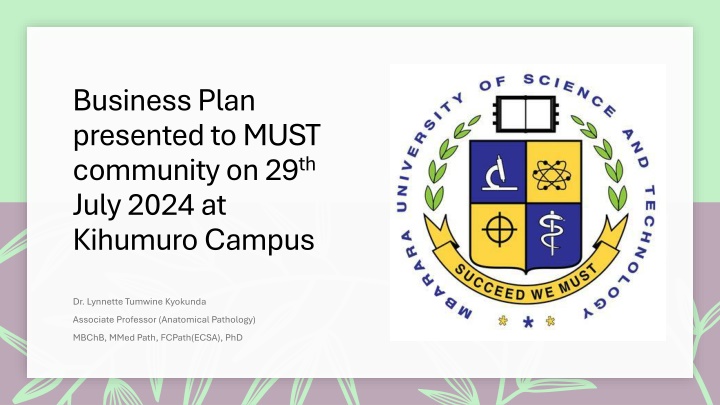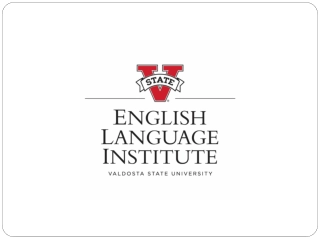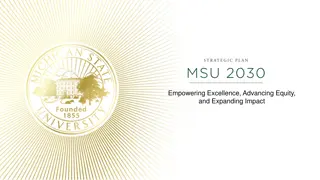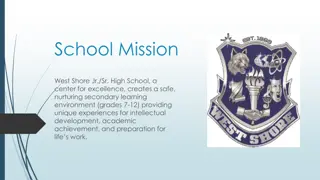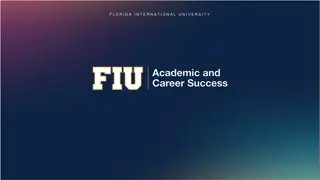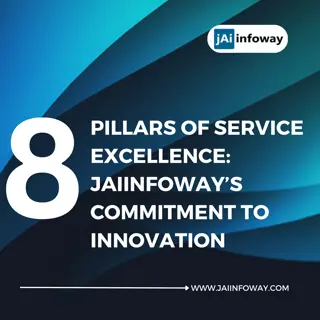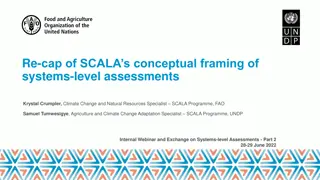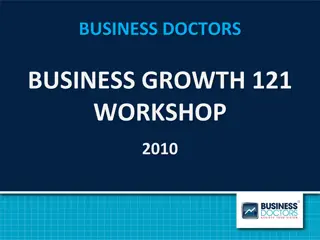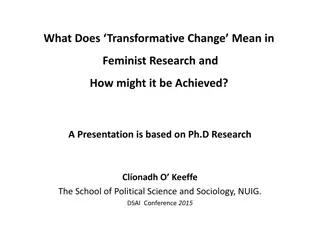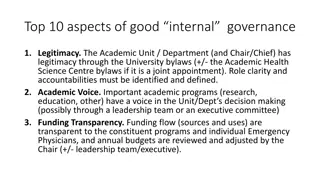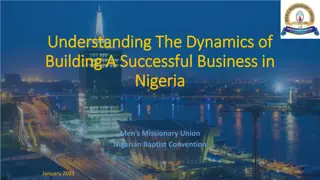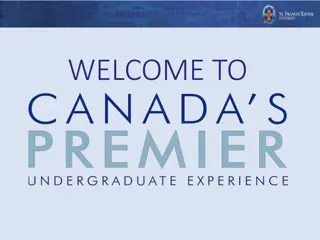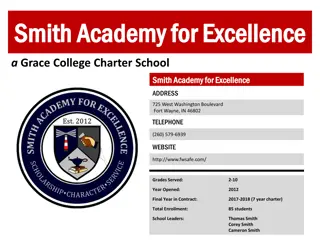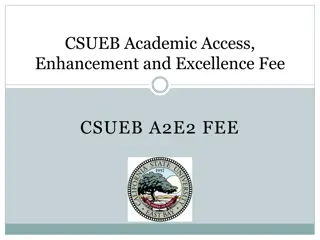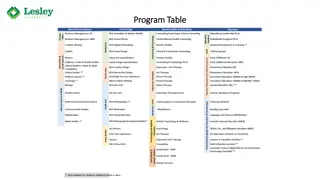Transformative Business Plan for Academic Excellence
Proposed in a business plan presentation at the Kihumuro Campus, this vision aims to establish a national and regional center of academic and professional excellence in science and technology. The plan includes strategic goals to develop human capital, recruit quality staff, offer impactful programs, promote innovation, and enhance community engagement. Implementation strategies focus on criteria for admission, transformative learning, ethical values, and entrepreneurship. The goal is to nurture informed, skilled, and ethical change agents for societal advancement through education and training.
Download Presentation

Please find below an Image/Link to download the presentation.
The content on the website is provided AS IS for your information and personal use only. It may not be sold, licensed, or shared on other websites without obtaining consent from the author.If you encounter any issues during the download, it is possible that the publisher has removed the file from their server.
You are allowed to download the files provided on this website for personal or commercial use, subject to the condition that they are used lawfully. All files are the property of their respective owners.
The content on the website is provided AS IS for your information and personal use only. It may not be sold, licensed, or shared on other websites without obtaining consent from the author.
E N D
Presentation Transcript
Business Plan presented to MUST community on 29th July 2024at KihumuroCampus
Outline Proposed Vision and Mission Proposed Strategic Goals Proposed Implementation Strategies Proposed Performance Metrices and Evaluation Proposed Financial and Resource Acquisition and Allocation Proposed Risk Management and Contingency Planning
Vision: A National and Regional Centre of Academic and Professional excellence in Science and Technology. Mission: To contribute to the socioeconomic transformation of Uganda through high quality human capital development in science and technology. These cadres will have the attributes of experts and professionals Change agents with ethical values for the common good. Use their knowledge and professionalism to improve their condition and that of their community. Informative, formative and transformative learning.
Proposed strategic goals 1. To develop well-rounded human capital for socioeconomic transformation who are change agents with ethical values and of common good. 2. To recruit and retain high quality globally competitive academic staff. 3. To provide high quality academic programs that are fit for purpose. 4. To develop and strengthen research , discovery, innovation and invention for community development, enterprise and service. 5. To maximize revenue and investment for sustainable growth. 6. To strengthen community engagement.
African stool Service See patients Teach Come across questions with no answers Research
Implementation strategies Four (4) Cs Criteria for admission ?Pre-entry examination Competencies Channels and Career pathways Induction of new students/ Transformative learning Ethical values Change agents confront an issue and be part of the solution Growing a new generation of citizens with a common good Patriotism Entrepreneurship (mandatory) The entrepreneurship mindset needs to be incalcatedin our pupils/students. Quality Assurance System based curricula To improve performance of health systems by adapting core professional competencies to specific contexts, while drawing on global knowledge.
Education and training are critical Level Objectives Outcomes Informative Knowledge Skills Experts Formative Socialization Values Professionals Transformative Leadership attributes Enlightened change agents
Required attributes and competencies Prepared to work where services are most needed: selection process, attitudes, socially accountable. Able to respond to health and societal needs: training in real life situations in the community is key. Able to deliver quality care with available (limited) resources. (Achieving the most with available resources). Clinical excellence as foundation for teaching and research. Able to be leaders and change agents: mentors Continuous self-directed learners. Effective communicators: team based learning practice.
The triangle that moves the mountain Knowledge creation Social mobilization Political involvement
Performance metrices and evaluation 1. Well rounded human capital developed for socioeconomic transformation( Change agents with ethical values and of common good). High quality academic staff recruited and retained. High quality academic programs that are fit for purpose developed. High quality research and innovation for community development, enterprise and service developed and strengthened. University revenue maximized. Community engagement strengthened. Number of well-rounded graduates who are change agents in their areas of jurisdiction. Number of graduates that work/serve in peri- urban and rural settings. Number of high-quality staff recruited Ratio of senior to junior staff Number of high-quality academic programs and programs developed and strengthened. Number of publications, patents and innovations. Number of new grants won. Number of awards given Number of new funding partnerships established. Number of new community sites engaged. 2. 3. 4. 5. 6.
Financial Resource Acquisition and Allocation Traditional sources of income for MUST: Government subsidy Tuition fees Industry research funds Success Nothing succeeds like success Reputation crucial for attracting funding Building a reputation as an accountable institution. Strong community-based programs for health promotion and disease prevention. Allocated to infrastructure development /research project funds help with project investigator (10- 20%) time effort. Key responsibility will be to raise philanthropic and corporate social responsibility donations, locally and internationally Approach the many organizations in the global north are interested in funding higher education in Africa. A chief development office will be needed to support this important activity.
Risk Management and Contingency planning The risk will be mitigated by implementation of a strategic program and qualification matrix plan aligned to external accreditation and comprehensive internship and learner- ship with robust review of programs. Controls will be the NCHE program accreditation processes. Will be mitigated by a new research strategy, to strengthen research management structures and systems, and to improve research skills, resources, research planning, performance, monitoring and evaluation. Will be mitigated by a community engagement strategy. 1. Failure to develop human capital for socioeconomic transformation who are change agents with ethical values and of common good. 2. Failure to develop high quality academic programs that are fit for purpose. 3. Failure to develop high quality research and innovation for community development, enterprise and service. 4. Failure to drive the development, monitoring and implementation of the community development strategy.
Risk Management and Contingency planning continued Failure to stabilize, organize, strengthen and diversity the University s financial base to support the strategic direction of the university. Controls are weak due to dependance on the government funding, a highly prescriptive and incremental approach to budgeting and a poor record of generating third and fourth stream income. Failure to establish a university-wide quality management system. Risk mitigated by the development, monitoring and implementation of a university-wide quality management system. Failure to recruit globally competitive academic staff with a good mix of senior and junior staff per department. Risk mitigated by ensuring the development, implementation and monitoring of academic recruitment plan that ensures a good mix of both senior and junior staff.
Conclusion: I am clear about what I am expected to do as VC. Open minded Decisive Collaborative Results oriented I am prepared for this job and this is what I will do.
